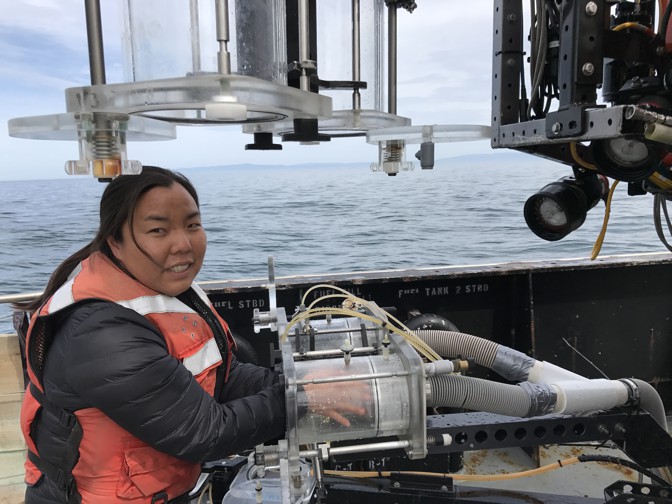We Were Missing Most of the Plastic in the Ocean

Anela Choy studies the things that deep-sea creatures eat, which means that, in effect, she is often studying plastic. Over the years, pieces of debris would show up again and again in the stomachs of certain fish, species that rarely come to the surface to feed. The plastic, she realized, must be going down to them.
Microplastics—tiny pieces less than five millimeters in size—have largely been studied as a problem of the ocean surface. Plastic tends to be buoyant, the thinking goes, and the ocean surface is frankly easier to study. But Choy, who is a biological oceanographer now at the University of California at San Diego, wanted to go deeper. In 2017, she and a team sent a specially designed remote-operated vehicle (ROV) down 3,200 feet in California’s Monterey Bay, systematically sampling up and down the water column.

It turns out that far more microplastics are hidden deep in the ocean than on the surface. The ROV found the highest concentrations of microplastics in water 200 to 600 meters, or 650 to 2,000 feet, below the surface. What’s more, those levels were comparable to the concentration closer to the surface of the infamous Great Pacific Garbage Patch, where ocean currents trap microplastics.
If anything, Monterey Bay is famously clean. “The Monterey Bay is considered a success story. It’s a beautiful place. The sardine and fish population have come back from crashes in the mid-1900s,” says Kyle S. Van Houtan, the chief scientist at the Monterey Bay Aquarium and a co-author of the study. “However, if you go below the surface, there’s more of a concentration of plastic than where many people consider the dirtiest: the Great Pacific Garbage Patch.”
Read: How plastic cleanup threatens the ocean’s living islands
In another way, though, all the plastic in the deep ocean is not a surprise. Scientists estimated the amount of plastic going into the ocean, and the number far exceeded what they were seeing in the water. “We’ve known for a long time if we just sample from the ocean surface, it doesn’t add up, so it must be going somewhere,” says Tamara Galloway, an ecotoxicologist at the University of Exeter who was not involved with the study. Where the missing plastic went was down.
The team also found microplastics as deep as they could sample with their ROV, which was 3,200 feet. Earlier this year, another group found plastic fibers in the guts of animals that live in the 36,000-foot-deep Mariana Trench, the lowest point on Earth. The Monterey Bay study suggests that microplastics are not just present below the surface of the ocean, but may be abundant.
Choy says it’s unclear exactly why most of the plastic seems to be hanging out in the 200-to-600-meter zone. There could be physical explanations, such as the density of the plastic and the movement of water. There could also be biological explanations, such as the way plastic moves through the food web. Choy and her team’s ROV also collected “sinkers,” which are sticky mucous houses that animals called larvaceans build and discard every day. Larvaceans use their mucous houses to filter feed, and they invariably catch microplastics. As sinkers fall through they water, they bring nutrients down to the deep sea. Anglerfish, vampire squid, and deep-sea cucumbers all eat sinkers and, consequently, they all eat microplastics.
When animals eat microplastics, they are, obviously, not eating food. The material can clog their guts. The chemistry of plastic also means the material tends to attract pollutants in the ocean water, making it even more dangerous to eat.
Read: A troubling discovery deep in the ocean
After Choy and her colleagues collected all of their microplastic pieces, they wanted to identify the kind of plastic, too. “That was a very—oh my gosh, that was a very manual effort, if you’d like,” she says, clearly remembering exactly how much work it took. Her co-authors at Arizona State University sorted hundreds of pieces of microplastic by hand and identified the plastic using a laser. They found that most of the plastic was polyethylene terephthalate, the type that goes into single-use plastics such as food packaging.
As the problem of plastic pollution has gained attention, so have viral solutions, such as the Ocean Cleanup, a 2,000-foot-long floating boom meant to collect plastic on the surface. The tube broke in testing, without collecting much plastic (a result experts could have predicted). The deep ocean is harder to reach, dark, cold, and under immense pressures. It’s hard to imagine how to even begin removing plastics there. “The best approach is to stop chucking so much in the ocean in the first place,” Galloway says. “That’s always going to be the best approach.”
We want to hear what you think about this article. Submit a letter to the editor or write to letters@theatlantic.com.









Follow Us!